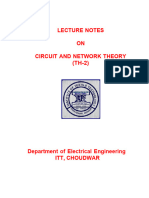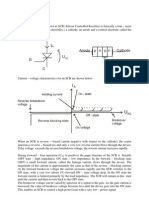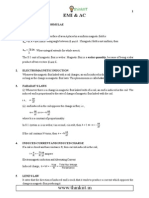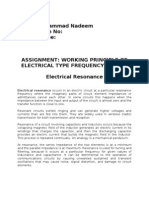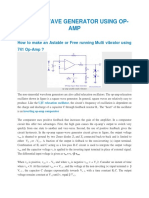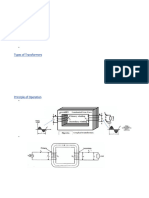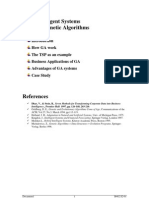0 ratings0% found this document useful (0 votes)
97 viewsMechanical Work Done in A Singly Excited System
This document discusses mechanical work done in a singly excited magnetic system. It describes how the work done depends on whether the armature movement is slow or instantaneous. For slow movement, the exciting current remains nearly constant as the flux linkage increases from Ψ1 to Ψ2, resulting in mechanical work equal to the area OACA'O. For instantaneous movement, a counter EMF is induced that opposes the exciting current, meaning the operating point moves along the vertical line AC instead of along the flux curve. The mechanical work is then equal to the area enclosed by OACDFO minus the area OA'CDFO.
Uploaded by
Anonymous TJRX7CCopyright
© © All Rights Reserved
Available Formats
Download as PPT, PDF, TXT or read online on Scribd
0 ratings0% found this document useful (0 votes)
97 viewsMechanical Work Done in A Singly Excited System
This document discusses mechanical work done in a singly excited magnetic system. It describes how the work done depends on whether the armature movement is slow or instantaneous. For slow movement, the exciting current remains nearly constant as the flux linkage increases from Ψ1 to Ψ2, resulting in mechanical work equal to the area OACA'O. For instantaneous movement, a counter EMF is induced that opposes the exciting current, meaning the operating point moves along the vertical line AC instead of along the flux curve. The mechanical work is then equal to the area enclosed by OACDFO minus the area OA'CDFO.
Uploaded by
Anonymous TJRX7CCopyright
© © All Rights Reserved
Available Formats
Download as PPT, PDF, TXT or read online on Scribd
You are on page 1/ 9
Mechanical Work Done
in a Singly excited system
Mechanical Work Done
Consider the simple magnetic relay again, the movable end of
armature is assumed to be held in open position.
When the switch S is closed, the exciting current increases
from Zero(0) to I
1
= Vt / r and flux linkage rises from Zero to 1.
Here r is coil resistance.
Consider the fig. shown:-
The moveable end of the Armature is assumed in closed
Position.
When switch S is closed the exciting current rises from Zero to
I1 = Vt / r.
Whereas flux linkage rises from zero to 2 [2 > 1].
The energy stored in the magnetic field is now given by the
cross-hatched area OCDO.
During the armature movement from its open position, the
reluctance of the magnetic path decreases, thereby increasing
the flux linkage from its initial value of 1.
These increments in flux linkage induces a counter Emf in the
coil, which opposes the flow of exciting current I,
ie.
The that magnitude of counter Emf induced in the exciting coil
depends on how fast the armature moves.
The two extreme cases of armature motion are considered
below:-
Slow Movement: -
With the armature in open position
the exciting current is I
1;
the flux
linkage are 1 and operating point
is A.
In closed position the flux linkage
is 2 , current is I
1
and operating
point is C.
The slow movement of armature causes almost negligible
counter Emf
as
Time
1 2
As a result , exciting current I1 remains almost constant during
armature movement and operating
point is A reaches new operating
point C along vertical line AC
as shown:--
Now magnetic energy stored
Changed during the process
Wfld =(Energy stored in closed position)-(Energy stored in open)
Wfld = Area OACDFO Area OAAFO
Electrical energy input during this change:-
Area ACDFAA
But
Welec =Wmech + Wfld
Wmech = Area OACDFO Area OACDFO
= Area OACAO
) ( .
1 2 1
2
1
1
I d I W
elec
Instantaneous Movement
You might also like
- Experiment FT2: Measurement of Inductance and Mutual InductanceNo ratings yetExperiment FT2: Measurement of Inductance and Mutual Inductance8 pages
- Name: Muhammad Nadeem Registration No: Course NameNo ratings yetName: Muhammad Nadeem Registration No: Course Name5 pages
- Square Wave Generator Using Op-AMP: How To Make An Astable or Free Running Multi Vibrator Using 741 Op-Amp ?No ratings yetSquare Wave Generator Using Op-AMP: How To Make An Astable or Free Running Multi Vibrator Using 741 Op-Amp ?2 pages
- Week 7-Transformers Voltage Regulation and Per Unit calculations-ELEC2300No ratings yetWeek 7-Transformers Voltage Regulation and Per Unit calculations-ELEC230030 pages
- Exp-1 To Get The Hysteresis Loop of Ferromagnetic Material.No ratings yetExp-1 To Get The Hysteresis Loop of Ferromagnetic Material.6 pages
- Chapter 16 Alternating Current Short QuestionNo ratings yetChapter 16 Alternating Current Short Question3 pages
- 11.1 - Electromagnetic Induction - (HL)No ratings yet11.1 - Electromagnetic Induction - (HL)40 pages
- Microgrids and The Grid Interaction: © Alexis Kwasinski, 2010No ratings yetMicrogrids and The Grid Interaction: © Alexis Kwasinski, 201031 pages
- Analysis For Power System State EstimationNo ratings yetAnalysis For Power System State Estimation9 pages
- Controller Form: 4. Building The User Interface LayerNo ratings yetController Form: 4. Building The User Interface Layer5 pages
- 10133eee16 Power System Transients 3 0 0 3No ratings yet10133eee16 Power System Transients 3 0 0 32 pages
- B620 Intelligent Systems Topic 4: Genetic AlgorithmsNo ratings yetB620 Intelligent Systems Topic 4: Genetic Algorithms8 pages
- Experiment FT2: Measurement of Inductance and Mutual InductanceExperiment FT2: Measurement of Inductance and Mutual Inductance
- Name: Muhammad Nadeem Registration No: Course NameName: Muhammad Nadeem Registration No: Course Name
- Square Wave Generator Using Op-AMP: How To Make An Astable or Free Running Multi Vibrator Using 741 Op-Amp ?Square Wave Generator Using Op-AMP: How To Make An Astable or Free Running Multi Vibrator Using 741 Op-Amp ?
- Week 7-Transformers Voltage Regulation and Per Unit calculations-ELEC2300Week 7-Transformers Voltage Regulation and Per Unit calculations-ELEC2300
- Exp-1 To Get The Hysteresis Loop of Ferromagnetic Material.Exp-1 To Get The Hysteresis Loop of Ferromagnetic Material.
- Exercises in Electronics: Operational Amplifier CircuitsFrom EverandExercises in Electronics: Operational Amplifier Circuits
- Microgrids and The Grid Interaction: © Alexis Kwasinski, 2010Microgrids and The Grid Interaction: © Alexis Kwasinski, 2010
- Controller Form: 4. Building The User Interface LayerController Form: 4. Building The User Interface Layer
- B620 Intelligent Systems Topic 4: Genetic AlgorithmsB620 Intelligent Systems Topic 4: Genetic Algorithms








